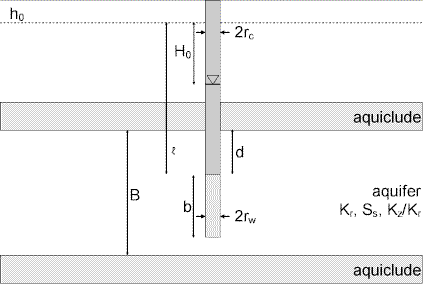Butler and Zhan Slug Test Solution for Confined Aquifers
Related Solution Methods
Additional Topics

 A mathematical solution by Butler and Zhan (2004) is useful for determining the hydraulic conductivity, specific storage and hydraulic conductivity anisotropy ratio of confined aquifers. The solution accounts for inertial effects in the well and oscillatory (underdamped) response. Analysis involves matching a type curve to water-level displacement data collected during a slug test.
A mathematical solution by Butler and Zhan (2004) is useful for determining the hydraulic conductivity, specific storage and hydraulic conductivity anisotropy ratio of confined aquifers. The solution accounts for inertial effects in the well and oscillatory (underdamped) response. Analysis involves matching a type curve to water-level displacement data collected during a slug test.
AQTESOLV provides visual and automatic methods for matching the Butler and Zhan solution to slug test data. This easy-to-use and intuitive software promotes rapid and accurate determination of aquifer properties.
Assumptions
The following assumptions apply to the use of the Butler and Zhan method:
- aquifer has infinite areal extent
- aquifer is homogeneous and of uniform thickness
- aquifer potentiometric surface is initially horizontal
- control well is fully or partially penetrating
- a volume of water, V, is injected or discharged instantaneously from the control well
- aquifer is confined
- flow is unsteady
- water is released instantaneously from storage with decline of hydraulic head
Solution
Options
AQTESOLV provides the following options for the Butler and Zhan solution for underdamped slug tests:
- partially penetrating wells
- hydraulic conductivity anisotropy
- observation wells
References
Butler, J.J., Jr. and X. Zhan, 2004. Hydraulic tests in highly permeable aquifers, Water Resources Research, vol. 40, W12402, doi:10.1029/2003WR002998.